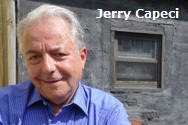Books About the Mob
Mob Boss: The Life Of Little Al D'Arco, The Man Who Brought Down The Mafia
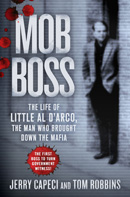 Mob Boss: The Life of Little Al D'Arco, The Man Who Brought Down The Mafia,
the sizzling hot book by Jerry Capeci and Tom Robbins is available at
bookstores everywhere. It's also available online at Amazon.com and Barnes & Noble
now for much less than the $27.99 list price. You can also get it from
Apple,
from
BooksAMillion, as well as an
independent book
seller near you.
Mob Boss: The Life of Little Al D'Arco, The Man Who Brought Down The Mafia,
the sizzling hot book by Jerry Capeci and Tom Robbins is available at
bookstores everywhere. It's also available online at Amazon.com and Barnes & Noble
now for much less than the $27.99 list price. You can also get it from
Apple,
from
BooksAMillion, as well as an
independent book
seller near you.
D'Arco was the first acting Mafia boss to cooperate when he flipped in 1991. His testimony helped send more than 50 mob figures to prison, and his decision to defect prompted many others to follow his lead, including then-Gambino family underboss, Sammy Bull Gravano.
You can tour the tough streets near the Brooklyn Navy Yard where Al D'Arco was raised, and follow him through the Mafia social clubs of Little Italy and south Brooklyn on this special Google map of Al D'Arco's New York.
Jerry Capeci stopped in to talk with WBGO's award winning radio commentator Allan Wolper about covering mob funerals, Mob Boss, midnight phone calls from Bruce Cutler, and the world of organized crime. Check out the special edition of Conversations With Allan Wolper.
Listen to Brian Lehrer's public radio interview of Jerry Capeci and Tom Robbins about Mob Boss, their sizzling hot new book about Alfonso (Little Al) D'Arco, through this online link. They discuss D'Arco's value as a government witness, his reasons for defecting from the Mafia, and the status of the new, emerging ethnic crime groups.
The New York Times review says Mob Boss is a "gripping, novelistic biography ... a bulls-eye."
Co-authors Jerry Capeci and Tom Robbins spent an hour chatting with Guardian Angels founder Curtis Sliwa about Little Al and a host of other topics, including John A. Gotti, the erstwhile Junior Don whom the outspoken radio talk show host would like to see go to hell without an asbestos suit for allegedly ordering Sliwa's shooting during a taxi cab ride from hell back in 1992.
A few days before legendary WOR radio personality John Gambling announced that he was retiring after 27 years on the air, he and Jerry Capeci talked about the life and times of Little Al D'Arco and the immense impact his decision to flip had on the world of organized crime.
Listen to two radio reports about Mob Boss and Little Al D'Arco by 1010 WINS investigative reporter Juliet Papa.
Check out the walk-talk through Little Al's old haunts in Little Italy that Wall Street Journal columnnist Ralph Gardner took with co-authors Capeci and Robbins.
If you were in Little Italy in early October, you could have snagged an autographed copy at McNally Jackson, at 52 Prince Street, across the street from where Little Al used to enjoy pasta e fagiole at Ray's Pizza, and a few blocks from where he ran his own four star restaurant on Cleveland Place.
"Just a superb book," says Pete Hamill.
"A genuinely great mob story about a genuine New York gangster by two of the city's best reporters," says Jimmy Breslin.
Read more about Mob Boss in the Village Voice, or in two Mob Boss excerpts that ran in the New York Post, including one about Ray's Pizza, where much more than pies were on the menu.
The Canary That Couldn't Fly
 For the better part of seven decades, mob aficionados and just plain folk have debated the mysterious demise of Abe (Kid Twist) Reles, who plunged to his death from a sixth floor window of a Coney Island hotel where police were guarding him for a potential court appearance against murderous mob boss Albert Anastasia.
For the better part of seven decades, mob aficionados and just plain folk have debated the mysterious demise of Abe (Kid Twist) Reles, who plunged to his death from a sixth floor window of a Coney Island hotel where police were guarding him for a potential court appearance against murderous mob boss Albert Anastasia.
Most people on both sides of the law have long disputed the official findings by authorities — in 1941 and again in 1951 by a special grand jury — that Reles had been trying to escape from the fortress-like Half Moon Hotel "squealer's suite" where he had been housed for nearly two years.
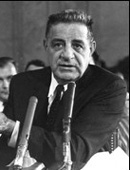 "I never met anybody who thought Abe went out that window because he wanted to," said Joe Valachi when he broke his vow of omerta. On the other side of the aisle, prosecutor Burt Turkus, who used Reles as a witness to send killers to the electric chair, wrote in his 1951 book, Murder Inc., that the escape theory made no sense and that foul play was involved.
"I never met anybody who thought Abe went out that window because he wanted to," said Joe Valachi when he broke his vow of omerta. On the other side of the aisle, prosecutor Burt Turkus, who used Reles as a witness to send killers to the electric chair, wrote in his 1951 book, Murder Inc., that the escape theory made no sense and that foul play was involved.
Surely, too many years have passed for any positive definitive answer to emerge now to all the questions surrounding Reles' death to emerge now.
But, after 10 years of dogged research, a history buff who was born in Brooklyn and settled in Chicago in 1983 has penned a fascinating book that examines all the political machinations and blood and guts violence of the era to some up with a very plausible solution to what may be the most undying unsolved mystery in the history of organized crime in America.
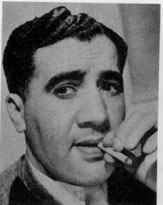 In The Canary Sang But Couldn't Fly, unknown author Edmund Elmaleh — who became intrigued by the Reles (left) case after first looking into some of his own family's possible ties to legendary Jewish gangster Lepke Buchalter — not only does an excellent job of relating and analyzing the case's compelling facts and unanswered questions; he makes it interesting too!
In The Canary Sang But Couldn't Fly, unknown author Edmund Elmaleh — who became intrigued by the Reles (left) case after first looking into some of his own family's possible ties to legendary Jewish gangster Lepke Buchalter — not only does an excellent job of relating and analyzing the case's compelling facts and unanswered questions; he makes it interesting too!
Through previously classified FBI reports, Elmaleh discloses that J. Edgar Hoover's FBI worked closely with former Brooklyn DA William O'Dwyer to keep Reles alive as he traveled around the country testifying in grand juries from Chicago to Los Angeles. Contrary to his public pronouncements, O'Dwyer, who would later ride Reles's testimony to two elections as Mayor, "did fear losing Reles to a mob bullet."
Sadly, however, just as Elmaleh completed his book last November 6, he died at age 49 of a sudden, massive heart attack.
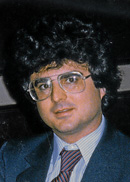 "Eddie had just finished doing the flap copy for the book jacket, and had hit the send button," recalled Kathi Kapell, a medical editor who lived with Elmaleh for 18 years. "One minute he was talking and the next minute he wasn't."
"Eddie had just finished doing the flap copy for the book jacket, and had hit the send button," recalled Kathi Kapell, a medical editor who lived with Elmaleh for 18 years. "One minute he was talking and the next minute he wasn't."
When Elmaleh began his project, Kapell told Gang Land, "he had an aunt still living in Brooklyn who told him not to get involved. 'It won't come to any good,' she said."
Five months after his death, Kapell still misses her longtime lover, but has only a little difficulty speaking about his long term project.
"Eddie was an intellectually curious person who loved history, the mob and mafia lore. He was really looking forward to seeing it in print. His first book. But it's really not painful talking about it. I'm so proud of him," she said.
FBI's Mr. Big Rips FBI Bosses
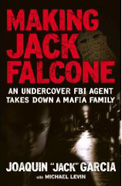 Now that the FBI's super undercover agent has made his network bones on 60 Minutes regarding his astounding secret missions, Gang Land is free to discuss what the ex-G-man has to say about some of his old bosses.
Now that the FBI's super undercover agent has made his network bones on 60 Minutes regarding his astounding secret missions, Gang Land is free to discuss what the ex-G-man has to say about some of his old bosses.
Warning: It ain't pretty.
Joaquin (Jack) Garcia, who took down the leadership of the Gambino crime family in an elaborate sting operation says that "shortsighted" FBI bureaucrats blew a golden opportunity to decimate the "five families" by ending the investigation soon after he was proposed to become a "made man."
Garcia also says that a double-dealing supervisor who was the driving force to shut down the 27-month probe took vindictive actions against him that could have blown his cover and gotten him killed because he questioned the decision to end the investigation in early 2005.
Garcia, who was lauded by New York FBI boss Mark Mershon as one of the best undercover agents in the 100-year history of the FBI, levels his accusations in Making Jack Falcone, his book that tells the inside story of the agent's infiltration into the Gambino family.

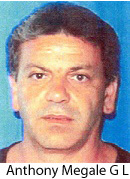 The blockbuster book touches on several roles that the burly, 390-pound Cuban-born émigré used during his 26 years on the job, almost all as an undercover agent. But the tell-all tome focuses primarily on his role as "Big Jack Falcone," a jewel thief and wannabe wiseguy whose work led to the convictions of 32 mobsters and associates, including the family's two top gangsters in 2005 — acting boss
Arnold (Zeke) Squitieri (left) and underboss Anthony (The Genius) Megale (right).
The blockbuster book touches on several roles that the burly, 390-pound Cuban-born émigré used during his 26 years on the job, almost all as an undercover agent. But the tell-all tome focuses primarily on his role as "Big Jack Falcone," a jewel thief and wannabe wiseguy whose work led to the convictions of 32 mobsters and associates, including the family's two top gangsters in 2005 — acting boss
Arnold (Zeke) Squitieri (left) and underboss Anthony (The Genius) Megale (right).
In the book, Garcia praises and thanks by name hundreds of agents, prosecutors and other federal, state and local law enforcers who helped him pull off the Falcone sting and scores of other undercover roles he played to nail numerous drug dealers and corrupt cops during his long career.
But Garcia charges that the actions of three top FBI officials, including the White Plains based supervisor who headed the investigation, David Velazquez, to shut down the case before its time "enabled the entire institution of organized crime (to) dodge a bullet."
If the probe had continued, and Garcia had been "made," as wiseguy Jack Falcone he could have vouched for other undercover agents and the FBI could have made serious inroads into the Bonanno, Genovese, Colombo and Luchese families, he writes.
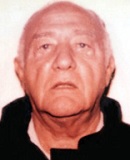 The end came in March, 2005, even though on several occasions, mobster Gregory
DePalma (left) was overheard telling "Jack Falcone," who had worked his way up to becoming the aging capo's bodyguard-chauffeur, that he was going to propose him to be made.
The end came in March, 2005, even though on several occasions, mobster Gregory
DePalma (left) was overheard telling "Jack Falcone," who had worked his way up to becoming the aging capo's bodyguard-chauffeur, that he was going to propose him to be made.
"There is only one thing I'm pushing to do, ASAP, is you. That would be the second guy (I sponsored.) I mean you want it, right?" DePalma said in one tape recorded talk.
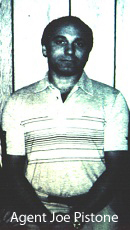 It's not unusual for an undercover agent to disagree with superiors about ending a risky, time-consuming, and costly undercover investigation: Joe Pistone, (right) who played the role of an up-and-coming mob associate for five years, wanted to continue his foray into the underbelly of the Bonanno crime family when FBI bosses pulled the plug on him back in 1981.
It's not unusual for an undercover agent to disagree with superiors about ending a risky, time-consuming, and costly undercover investigation: Joe Pistone, (right) who played the role of an up-and-coming mob associate for five years, wanted to continue his foray into the underbelly of the Bonanno crime family when FBI bosses pulled the plug on him back in 1981.
But current and former FBI agents tell Gang Land that they agreed with Garcia's position to keep the case going, and that even if it didn't lead to the monumental achievement of Garcia being inducted into the Gambino family, there were other goals that could have been attained.
Velazquez is not identified by name in the book. He declined to discuss the case with Gang Land. In the book, he is quoted as stating that he decided "to shut the case down because it met and exceeded all of its objectives. It was the right time to close it out."
That opinion was repeated by several FBI officials who spoke to Gang Land, including David Cardona, the head of New York's criminal division. Cardona said Garcia's work was "outstanding," but he backed the official determination, echoing comments from other officials that Garcia was "too close" to the case to make a truly objective decision.
But neither Cardona nor any of the other officials would dispute, or explain, the actions that Garcia lays on Velazquez after the agent asked for a meeting with New York organized crime superiors and Washington officials who oversee undercover operations to review Velazquez's decision and air out the differing positions.
The meeting was scheduled to take place at 26 Federal Plaza, the Downtown Manhattan office building that houses FBI headquarters. Garcia did not want to risk blowing his cover — and perhaps his life — by using the main entrance, so two agents agreed to pick him up in a Bureau car and drive him into the underground garage so he could attend without being made as an FBI agent in the lobby of the building.
A few minutes later, the agents called and told Garcia that Velazquez had prohibited them from picking him up. They also said Velazquez had told them that he was going to have Garcia "fired for insubordination for calling in headquarters."
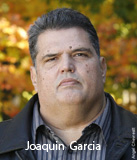 Garcia (left) could live with being fired, but he was concerned about living if he were recognized as an agent. He appealed that ruling, and a New York organized crime supervisor, who recognized the obvious danger of making an undercover agent walk into the lobby of the FBI building and flash his badge to enter, quickly rescinded that decision.
Garcia (left) could live with being fired, but he was concerned about living if he were recognized as an agent. He appealed that ruling, and a New York organized crime supervisor, who recognized the obvious danger of making an undercover agent walk into the lobby of the FBI building and flash his badge to enter, quickly rescinded that decision.
Garcia uses tough words to describe those on his side of the law with whom he clashed. He says there was "ineptness, idiocy, incompetence and inexperience" by FBI managers who investigated reports of a mob contract on his life.
Still, Garcia is unsure whether he has been marked for death. He doesn't really think that someone "will come and whack me" in retaliation. But his home is fully wired, he starts his car with a remote, and he always carries a gun.
"I'm not just blowing off steam when I say that the investigation into the alleged hit was poorly handled. The outcome in fact remains open," he writes. In a final word about the uncertainty ahead, he alerts the bureaucrats who bungled that probe: "So if you and I ever meet, don't walk too close!"
The Good Rat A Great Read
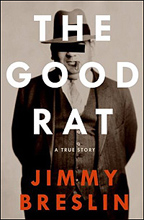 Watching Jimmy Breslin covering the Mafia Cops trial had Gang Land looking down the line for an intriguing, always unique, fun-filled, yet riveting read by the irascible Pulitzer Prize winning columnist-author.
Watching Jimmy Breslin covering the Mafia Cops trial had Gang Land looking down the line for an intriguing, always unique, fun-filled, yet riveting read by the irascible Pulitzer Prize winning columnist-author.
The Good Rat is all that, and more.
In addition to his word pictures and insights about Good Rat Burt Kaplan and murderous detectives Lou Eppolito (big, brazen and brawling) and Steve Caracappa (slender, stealthy, silent), Breslin gives breadth to many so-called minor players in the compelling saga.
There's the illiterate auto mechanic who feared for his life as he dug a grave for the dirty duo's first murder victim and lived with that fear for 19 more years, and the sister of a 26-year-old hoodlum they kidnapped and sent to his death. Before trial, when she found out Caracappa was living around the corner from her mom on Staten Island, she rang his bell and told him: "You motherfucker. I want to see you when they put handcuffs on you and take you away for the rest of your life."
Breslin discloses, as only he can, that the mob tradition of respectful kissing began when Sonny Franzese met Joe Brancato on the corner of Lorimer Street and Metropolitan Avenue in Greenpoint, Brooklyn, and that after losing the last race at Aqueduct one day, jockey Con (Scamp) Errico rode his mount right into nearby Pep McGuires, "the greatest bar in the history of the city," and the horse proceeded to drink water from a bucket that legendary gangster Jimmy Burke had placed on the bar.
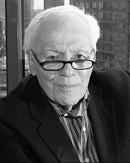 For the purists, there are countless pages of Kaplan's spell-binding trial testimony that sunk the rogue cops. For the rest of us there are Breslin's personal dealings with Tony Pro, Fat Tony and Tony Café as well as his account of how U Couraga, an Italian pit bull bested a challenger from The Bronx in a memorable battle at a mob graveyard near the Brooklyn-Queens border.
For the purists, there are countless pages of Kaplan's spell-binding trial testimony that sunk the rogue cops. For the rest of us there are Breslin's personal dealings with Tony Pro, Fat Tony and Tony Café as well as his account of how U Couraga, an Italian pit bull bested a challenger from The Bronx in a memorable battle at a mob graveyard near the Brooklyn-Queens border.
For everyone, there's Chapter Nine. It's a riveting, terrifying account of a $4000 dispute between the money-hungry Mafia Cops and a cheapskate mob psychopath and how it led to the tragic wrong man execution of a loved and loving, hard-working Brooklyn man with the same name as a mob hood who had been marked for murder.
Amazon's got it for $16.47.
Mafia
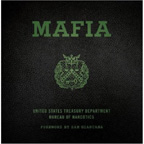 Mafia is a treasure trove of information about wiseguys who operated during the golden age of the mob. A MUST for mob buffs. A phone book-sized directory of mug shots and minutiae on more than 800 wiseguys that was compiled in the early 1960s by the Bureau of Narcotics and Dangerous Drugs.
Mafia is a treasure trove of information about wiseguys who operated during the golden age of the mob. A MUST for mob buffs. A phone book-sized directory of mug shots and minutiae on more than 800 wiseguys that was compiled in the early 1960s by the Bureau of Narcotics and Dangerous Drugs.
The book is said to be a reprint of an actual top secret dossier that the agency put together. Each gangster in the "just the facts" book — it's #31 of 50 copies that were produced — is relegated to a single page that lists his nicknames, haunts, associates, criminal and business interests in a brusque but colorful report.
Joe Batters Accardo, a "former member of the old Capone mob … claims to be a salesman for Premium Beer Sales Inc., 2555 W. Armitage Ave., Chicago, Ill." Another Chicago wiseguy, Leonard Calamia, "frequents the Poodle Dog Restaurant at 1121 Polk Street … when in San Francisco."
Francisco Castiglia, a.k.a. Frank Costello, "resides 115 Central Park West" and "frequents Biltmore and Waldorf Astoria hotels." Richie The Boot Boiardo has "bullet scar on left cheek" and "frequents Newark, N.Y.C., & gambling houses in Havana."
The BNDD database includes one-page reports on virtually all the gangsters you'd expect to see, and countless more you wouldn't. There's one on Luigi Fratto, of Des Moines, "the most influential member of the Mafia in the state of Iowa," and other reports about Benny (The Blimp) Barone, the Mafia leader of Omaha, Nebraska, and his crew of four Omaha-born and raised Biase brothers, Anthony, Louis, Bernard and Samuel.
Mafia lists for $35. Amazon's got it for $23.07.
Notorious New Jersey
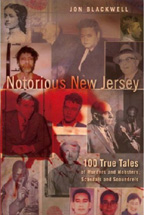 In Notorious New Jersey: 100 True Tales of Murders and Mobsters, Scandals and Scoundrels, author Jon Blackwell makes a decent case that, when it comes to powerful gangsters and mob rubouts, New Jersey mobsters often rise to the level — or sink to the same depths — as their Big Apple cousins across the Hudson River.
In Notorious New Jersey: 100 True Tales of Murders and Mobsters, Scandals and Scoundrels, author Jon Blackwell makes a decent case that, when it comes to powerful gangsters and mob rubouts, New Jersey mobsters often rise to the level — or sink to the same depths — as their Big Apple cousins across the Hudson River.
Until a heroin dealing conviction sent him to die in prison, Vito Genovese lived in splendor in the Garden State. So did Richie The Boot Boiardo, whose 17-acre estate was adorned with a statue of The Boot astride a white horse. Blackwell recounts the murders of beer baron gangster Dutch Schultz and Genovese underboss Willie Moretti and the bugged conversations that made mob boss Sam the Plumber DeCavalcante a household name decades before Tony Soprano arrived on the scene.
All told, 17 of Blackwell's 100 true crime stories involved gangsters, including transplanted New York mobster Giuseppe (Joe Adonis) Doto, who when asked why he re-located to the Garden State by a Senate Committee, said: "I liked the climate better."
Notorious New Jersey lists for $18.95. It's $12.89 at Amazon.
Tears & Tiers
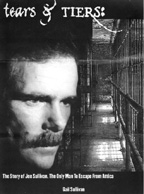 Tears & Tiers: The Life and Times of Joseph "Mad Dog" Sullivan, The Only Man To Escape From Attica, is a scary, disturbing book about Sullivan, a convicted bank robber, mob hitman and escape artist. Sullivan, 68, has spent about 45 years of his life in prison, and is serving a life sentence.
Tears & Tiers: The Life and Times of Joseph "Mad Dog" Sullivan, The Only Man To Escape From Attica, is a scary, disturbing book about Sullivan, a convicted bank robber, mob hitman and escape artist. Sullivan, 68, has spent about 45 years of his life in prison, and is serving a life sentence.
It is also a compelling, and touching read.
In the last paragraph of the preface, the author, his wife, Gail Sullivan, probably says it best: "The story isn't always pretty but I believe it's an important and interesting story that should be told. Just as importantly, no one will be hurt in its telling. This is a step into the life of the man I married, the man that I love with all of my heart, the man that gave me two fine sons that we both are very proud of, the man who law enforcement speculates might have murdered as many as thirty people."
Tears & Tiers is $15 at Amazon.
The Mafia Cops
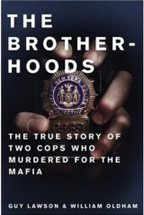 Gang Land readers interested in learning more details about the scandalous Mafia Cops saga of murderous ex-detectives Louis Eppolito and Stephen Caracappa have two other books to choose from.
Gang Land readers interested in learning more details about the scandalous Mafia Cops saga of murderous ex-detectives Louis Eppolito and Stephen Caracappa have two other books to choose from.
The Brotherhoods, The True Story Of Two Cops Who Murdered For The Mafia is a 509-page hardcover book co-authored by Willam Oldham, a retired NYPD detective who began investigating the murderous duo as a criminal investigator for the feds, and writer Guy Lawson. Amazon has it for $20.08, more than eight bucks off the list price.
Mob Cops, The Shocking Rise and Fall of New York's "Mafia Cops," is a 386-page soft cover publication written by Daily News reporter Greg B. Smith, who previously authored "Made Men, The True Rise-and-Fall Story of a New Jersey Mob Family. $7.99 at Amazon.
Oldham and Lawson begin their account with the arrest last year of Eppolito and Caracappa in Las Vegas. Smith starts his narrative in 1969 on a young Burt Kaplan, who would become the star witness against the rogue cops, as the budding gangster drives to Connecticut to dump the body of a murder victim whose name he never learned.
Both books are current. They end with the convictions of both men for eight murders that were overturned by trial Judge Jack Weinstein, and with the ex-detectives jailed without bail as they wait for a decision by the Second Circuit Court of Appeals on the government's appeal of Weinstein's ruling.
The Wiseguy Cookbook
 The
Wiseguy Cookbook, By Henry Hill and Priscilla Davis is an
entertaining and informative read. It's everything you wanted to know
about Hill's rituals and recipes for cooking that he learned from his
mother, as well as the innovative culinary skills he picked up along the
way, whether it was doing time or laying low in the Witness Protection
Program.
The
Wiseguy Cookbook, By Henry Hill and Priscilla Davis is an
entertaining and informative read. It's everything you wanted to know
about Hill's rituals and recipes for cooking that he learned from his
mother, as well as the innovative culinary skills he picked up along the
way, whether it was doing time or laying low in the Witness Protection
Program.
His mom's Italian heritage couldn't get him made, but the mob couldn't keep him out of her kitchen. She taught him well, although every so often he found a better way. Like with cutlets, for example. This applies to veal, chicken, pork. Eggplant too. His mom dipped them in egg and then in flour and breadcrumbs before frying.
According to Hill, the opposite way, flour and breadcrumbs first, then egg, makes for more mellow cutlets. Also, with his mom's way, "some of the breadcrumbs always fall into the oil and burn, so you have to start over with a new batch of oil after a couple of rounds of frying."
Sprinkled among staples like Pasta e Lenticchie (lentils) and Pasta con Sarde (sardines) are plenty of anecdotes about wiseguys like Paul Vario and Jimmy The Gent Burke, cooking in the Army, and in prison. And for Gang Land readers living in the heartland, Hill tells how to improvise and use substitute ingredients. From his days in the witness program, Hill knows how difficult it is to find arugula, let alone people who know what it is, in places like Omaha, Nebraska and Butte, Montana.
Available from Amazon.
Brooklyn: A State of Mind
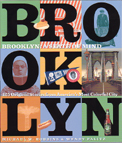 Brooklyn:
A State of Mind, edited by Michael W. Robbins & designed by Wendy
Palitz, is a must read for anyone who was born or raised in Brooklyn, or
spent a few years there, or, like the rest of the world, wishes they
had.
Brooklyn:
A State of Mind, edited by Michael W. Robbins & designed by Wendy
Palitz, is a must read for anyone who was born or raised in Brooklyn, or
spent a few years there, or, like the rest of the world, wishes they
had.
Published in 2001, the book is a collection of 125 original stories and a gazillion photos that bring to life people and places that have shaped the Borough of Churches over the last 100 years. Words and pictures of the Brooklyn Dodgers, Norman Mailer, Carmine Persico, Nathan's Famous, Jackie Gleason, Jackie Robinson, the Brooklyn Paramount, Abe Reles and the Half Moon Hotel, the Poet Laureate of Brooklyn. Interviews of Mel Brooks, Leonard Garment and Spike Lee. And much more.
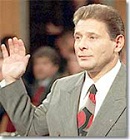 Of
special interest to mob buffs, and Gang Land, is a joint interview of
Brooklyn Federal Court Judges I. Leo Glasser and John Gleeson about the
1992 trial of John Gotti. Glasser,
the trial judge, and Gleeson, the lead prosecutor, were interviewed — the only out-of-court comments they have uttered — in 1999, a year
before star witness Salvatore (Sammy Bull)
Gravano was arrested for drug dealing, charges for which he is doing
20 years.
Of
special interest to mob buffs, and Gang Land, is a joint interview of
Brooklyn Federal Court Judges I. Leo Glasser and John Gleeson about the
1992 trial of John Gotti. Glasser,
the trial judge, and Gleeson, the lead prosecutor, were interviewed — the only out-of-court comments they have uttered — in 1999, a year
before star witness Salvatore (Sammy Bull)
Gravano was arrested for drug dealing, charges for which he is doing
20 years.
While neither judge said anything outrageous, even in hindsight, Gang Land is sure each wishes they had declined to discuss the case. For example, Gleeson, who was less restrained in his remarks than Glasser, described Gravano as "the best witness of all time …. He looked evil. Then Sammy flipped and I spent a great deal of time with him. Literally hundreds of hours. I got to know him well. I laughed with him. He was smart, engaging and funny."
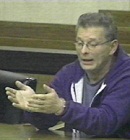 Glasser,
asked to describe the kind of man Gravano was, never gave his view,
noting only that jurors and investigators had "found him sincere when he
said he was attempting to put the life of organized crime behind him."
Glasser,
asked to describe the kind of man Gravano was, never gave his view,
noting only that jurors and investigators had "found him sincere when he
said he was attempting to put the life of organized crime behind him."
Asked about criticism that his five year sentence was too lenient, Glasser acknowledged, " I took a beating for that." But he ducked the real issue, never explaining how he justified it in his mind. Instead, he blamed the media for not publishing the sentencing memo he had "worked many hours preparing."
Glasser loosened up, however, when asked if there were "occasions for wit" in the Gotti trial. Often described as a grouch or curmudgeon, his response indicates he may also have loosened up at least once during the very tense trial.
"I suppose I had to use my wits one day when I received a note that some of the jurors, who'd been sequestered for weeks, were requesting conjugal visits. I called the only other federal judge I knew who had sequestered a jury. He said, 'What are you going to do, judge?' I said, 'I think I'll allow it.' He said, 'Good for you. I think that's what I would do.'"
Available from Amazon.

